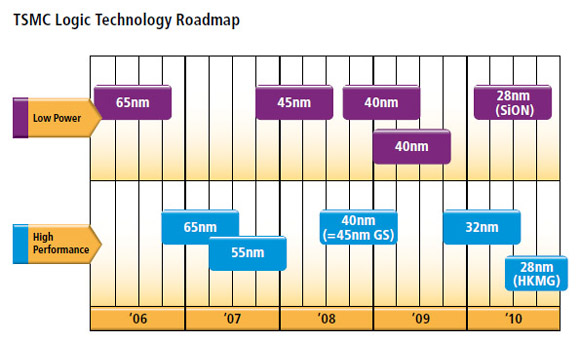One Year Later, GlobalFoundries Rapidly Ramping New Technologies
The company will ship 40nm LP (low power) silicon starting this quarter and 32nm SOI in the back half of 2010. The left edge of each box denotes 'risk production,' aka early commercial production. One of the reasons we originally contacted GF was to clear up some confusion around the 32nm/28nm process nodes. When GlobalFoundries first launched, the company claimed to be working on 32nm bulk silicon technology which has since vanished off the roadmap. We were also curious how the company realistically expected to ship 28nm bulk silicon just one quarter after it began volume production of 32nm SOI products.

GlobalFoundries is targeting a wide range of devices in both consumer and commercial space.
It turns out that when GlobalFoundries started meeting with potential customers, a significant number of them were more interested in 40nm than 32nm. GF company reps weren't able to officially comment on why so many companies were interested in 40nm, but we'd guess the reason starts with "T" and ends in "SMC yield problems." AMD and NVIDIA have been the two high-profile companies most hurt by the Taiwanese foundry's inability to ship functional 40nm products in sufficient volumes, but they're far from the only ones affected. TSMC claimed last month that they've resolved their 40nm problems. Of course, they've said that before. This time, we're dubious.

TSMC's roadmap for comparison. TSMC's decision to build transistors using SiOn at 28nm has been openly challenged by IBM.
The reason TSMC's yield problems became everyone's yield problems is because the company has had no competition at the 45/40nm process nodes. Once GF's 40nm process is ramped the world+dog will have access to multiple leading-edge fabrication facilities. GF plans to ramp its 28nm production just behind TSMC and it's already working on 22nm technology.
Peeking In on AMD:
GlobalFoundries will still be handling AMD's CPU manufacturing going forward, but the company wasn't able to tell us much in the way of new information. The company's 32nm production ramp is rumored to be going quite well; 32nm processors should ship in volume by the end of 2010. We've discussed Llano before—as AMD's first Fusion part, it bears the weight of justifying the original purchase of ATI and AMD's commitment to "Fusion" products to begin with.
We've mentioned that Llano will combine a CPU and GPU in a single die (Intel's approach with Westmere is to use two discrete packages on one substrate). One point we haven't discussed, however, is that this means Llano's GPU—presumably an integrated Radeon derivative—will be built on 32nm SOI. We don't know if AMD will shift from 40nm to 32nm at TSMC or jump straight from 40nm to 28nm, but Llano's GPU is probably unique. With Bulldozer and Bobcat chips launching on 32nm later in 2011, we're betting the GPU half of Llano ends up being a core AMD can easily bolt on to multiple processors without needing to reinvent the wheel.
Bulldozer and Bobcat, like Llano, will be built on 32nm SOI through 2011. GlobalFoundries is not planning a 28nm SOI process; AMD may or may not choose to use SOI at the 22nm node.
Conclusion:
One year after spinoff, GlobalFoundries has an array of customers, an aggressive roadmap, new foundries under construction in New York State, and the additional foundry assets it gained from its purchase of Chartered. Thus far, the AMD split appears to have been genuinely beneficial to both companies and the semiconductor industry as a whole should benefit from increased competition.

